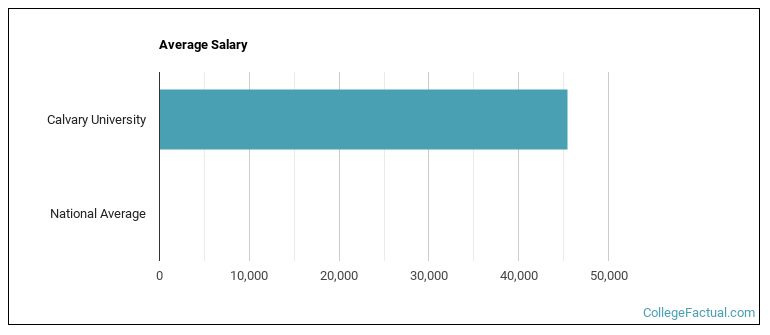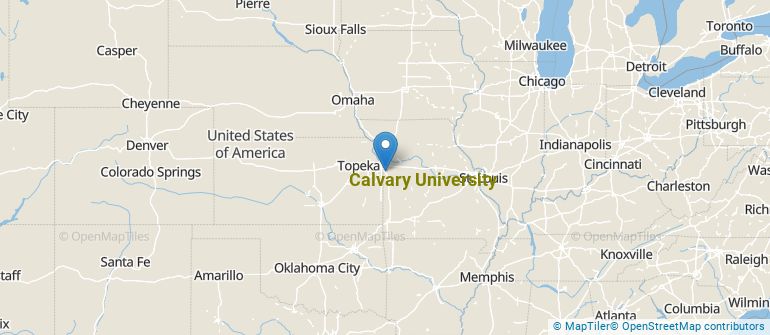 by our College Data Analytics Team
by our College Data Analytics TeamExplore the best ranked schools for the programs you are most interested in.
Calvary was not ranked in College Factual's 2025 Best Overall Colleges report. This could be for a number of reasons, including lack of data.
The acceptance rate at Calvary University is a competitive 63%, so make sure you take your application seriously when putting it together. Even leaving out a minor detail could be a reason to move you to the rejection pile.
About 25% of students accepted to Calvary submitted their SAT scores. When looking at the 25th through the 75th percentile, SAT Evidence-Based Reading and Writing scores ranged between 460 and 600. Math scores were between 410 and 570.
At Calvary, the student to faculty ratio is an excellent 8 to 1. That's much better than the national average of 15 to 1. This indicates that many classes will probably be small, and students will have ample opportunites to work closely with their professors and classmates.
When estimating how much access students will have to their teachers, some people like to look at what percentage of faculty members are full time. This is because part-time teachers may not have as much time to spend on campus as their full-time counterparts.
The full-time faculty percentage at Calvary University is 62%. This is higher than the national average of 47%.
Calvary University has a freshmen retention rate of 79%. That's a good sign that full-time students like the school and their professors enough to want to stick around for another year. It's also a sign that the admissions team did a good job in choosing applicants who were a good fit for the school.
The on-time graduation rate is the percent of first-time, full time students who obtain their bachelor's degree in four years or less. This rate is 26% for first-time, full-time students at Calvary, which is lower than the national rate of 33.3%.
Find out more about the retention and graduation rates at Calvary University.
During the 2017-2018 academic year, there were 376 undergraduates at Calvary with 172 being full-time and 204 being part-time.
| $0-30 K | $30K-48K | $48-75 | $75-110K | $110K + |
|---|---|---|---|---|
| $10,772 | $9,547 | $13,260 | $14,370 | $16,317 |
The net price is calculated by adding tuition, room, board and other costs and subtracting financial aid.Note that the net price is typically less than the published for a school. For more information on the sticker price of Calvary, see our tuition and fees and room and board pages.
While almost two-thirds of students nationwide take out loans to pay for college, the percentage may be quite different for the school you plan on attending. At Calvary, approximately 29% of students took out student loans averaging $5,966 a year. That adds up to $23,864 over four years for those students.

Get more details about the location of Calvary University.

Contact details for Calvary are given below.
| Contact Details | |
|---|---|
| Address: | 15800 Calvary Road, Kansas City, MO 64147-1341 |
| Phone: | 816-322-0110 |
| Website: | www.calvary.edu/ |
| Most Popular Majors | Bachelor’s Degrees | Average Salary of Graduates |
|---|---|---|
| Biblical Studies | 20 | NA |
| Other Multi/Interdisciplinary Studies | 18 | NA |
| Business Administration & Management | 16 | NA |
| Theological & Ministerial Studies | 16 | NA |
| Pastoral Counseling & Specialized Ministries | 8 | $23,330 |
| Teacher Education Grade Specific | 3 | NA |
| Music | 3 | NA |
| Educational Administration | 2 | NA |
| Drama & Theater Arts | 2 | NA |
| Sacred Music | 1 | NA |
Online courses area a great option for busy, working students as well as for those who have scheduling conflicts and want to study on their own time. As time goes by, expect to see more and more online learning options become available.
In 2022-2023, 238 students took at least one online class at Calvary University. This is a decrease from the 304 students who took online classes the previous year.
| Year | Took at Least One Online Class | Took All Classes Online |
|---|---|---|
| 2022-2023 | 238 | 150 |
| 2021-2022 | 304 | 226 |
| 2020-2021 | 392 | 257 |
| 2018-2019 | 202 | 101 |
Footnotes
*The racial-ethnic minorities count is calculated by taking the total number of students and subtracting white students, international students, and students whose race/ethnicity was unknown. This number is then divided by the total number of students at the school to obtain the racial-ethnic minorities percentage.
References
More about our data sources and methodologies.